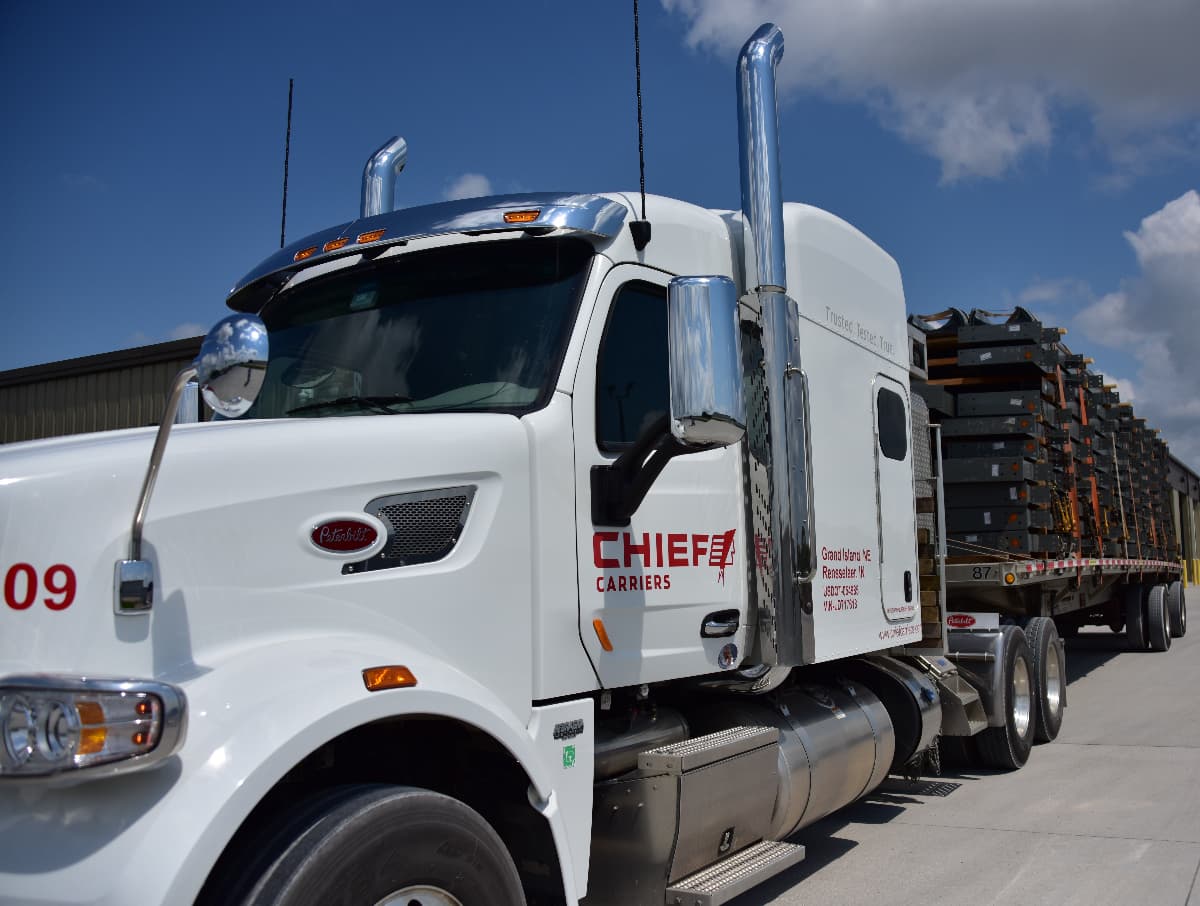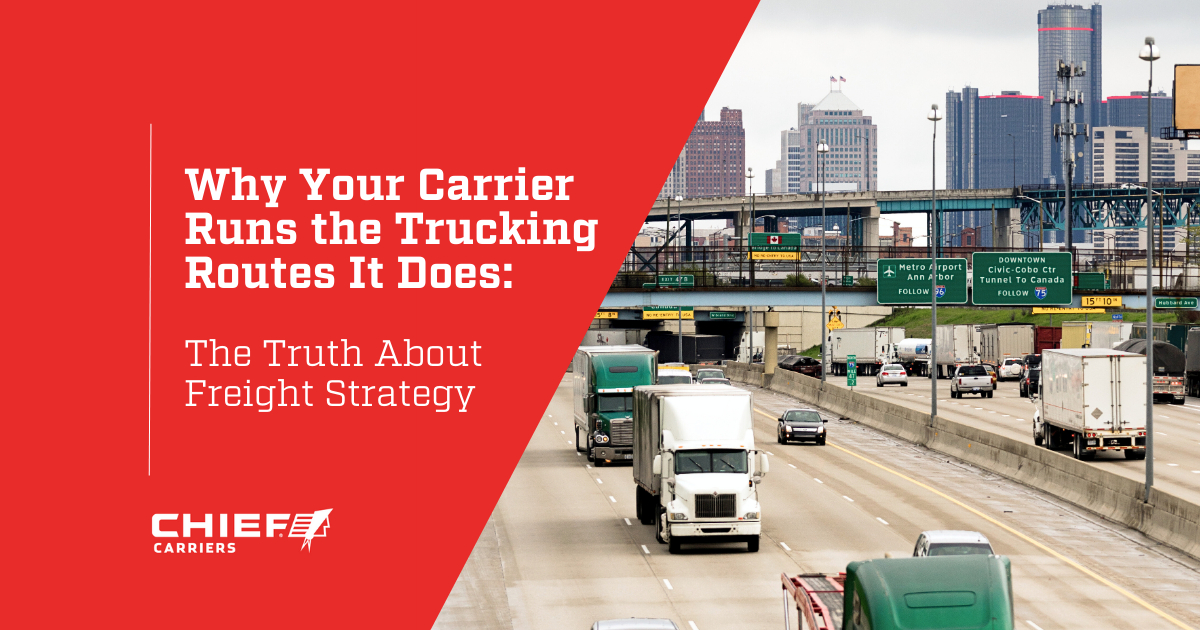How Trucking Companies Choose Routes for Profit and Predictability
Why does one carrier seem to run the same lanes consistently while another is all over the map? The answer isn’t random; it’s a carrier’s core business strategy.
At its heart, a trucking carrier’s choice of trucking routes is determined by its freight strategy: either operating on long-term freight contracts or chasing loads on the spot market trucking. The former prioritizes stability, efficiency, and predictable supply chains, while the latter is a high-risk, high-reward model.
Chief Carriers will pull back the curtain on these two models, sharing insights from our own operational experience to explain how strategic route planning can lead to significant supply chain efficiencies for shippers.

The Two Core Models of Trucking Operations
Understanding how trucking companies choose routes is key to understanding their business model. It comes down to a fundamental choice between stability and flexibility, which directly impacts everything from pricing to service reliability.
The Spot Market Model: Chasing the Next Load
The spot market is where shippers and carriers transact on an “as-needed” basis, with rates fluctuating based on real-time supply and demand. It’s often facilitated by a freight brokerage.
This model works by carriers finding available loads via load boards. They’re constantly searching for the next high-paying freight.
- Pros: Potential for high profit on individual loads when demand is high. It offers flexibility for carriers to go where the money is.
- Cons: Highly volatile and unpredictable rates. It’s inefficient for long-term planning and can lead to excessive “deadhead miles” (empty trailers) when a return load isn’t available.
If you work for a small carrier, maybe with 10 or 20 trucks, you’re most likely operating on the spot market more than the contract market.
-Andrew Winkler, General Manager of Chief Carriers

The Freight Contract Model: The Power of Dedicated Lanes
A freight contract is a long-term agreement between a carrier and a shipper for a set price over a defined period, often for specific, dedicated trucking routes, also known as power lanes.
A carrier partners with shippers to manage a consistent flow of goods on specific routes, ensuring predictable capacity and pricing.
- Pros: It provides a stable revenue stream and predictable costs. Truck route optimization is maximized, resulting in significantly reduced deadhead miles. This model builds stronger, more strategic relationships between shippers and carriers.
- Cons: Less flexibility to capitalize on short-term market spikes. It requires deep planning and significant operational expertise to execute effectively.
At Chief Carriers, our business is approximately 80% contract freight, with spot market accounting for the other 20%.
The contract freight is what you’re really chasing as a carrier because it’s going to bring stability, it’s repeatable, and it’s predictable.
-Andrew Winkler

How Key Industries Influence Routes
A trucking company’s power lanes aren’t random — they’re shaped by where industries are clustered and where freight consistently moves. These hubs create reliable, strategic routes that balance efficiency for customers and profitability for carriers, even when the lanes are busy or congested.
Steel and Industrial Goods
The Midwest has long been a powerhouse for steel, machinery, and other industrial goods. Chicago’s central location and vast highway and rail networks make it one of the most important freight hubs in the U.S.
For flatbed carriers like Chief Carriers, these lanes are critical because they connect factories, construction sites, and manufacturing plants across the region. Loads often include steel coils, lumber, and heavy equipment — the backbone of America’s building and manufacturing industries.
Construction and Energy
Cities with strong growth and infrastructure investment naturally become freight hubs for construction materials. Dallas–Fort Worth is one of the busiest inland freight markets because of its central location and population growth, creating steady demand for flatbed freight like building materials, pipe, and equipment.
The same is true in energy-producing regions, where the movement of drilling equipment, machinery, and fabricated steel keeps flatbeds rolling.
Imports and Exports
Ports drive enormous freight volumes. The Port of Los Angeles and the Port of Long Beach together form the busiest port complex in the U.S., serving as a gateway for imported steel, lumber, and machinery from Asia.
On the East Coast, Savannah, Georgia, has rapidly grown into a key hub for international trade, moving everything from construction products to raw materials. These ports don’t just keep dry vans full — they generate significant demand for flatbed equipment to move oversized and odd-shaped freight inland.
Automotive and Manufacturing
Detroit and the surrounding Midwest remain vital for automotive manufacturing, but the industry has also expanded into the Southeast — states like Kentucky, Tennessee, and Alabama. For flatbed carriers, this translates into steady demand for moving parts, machinery, and production equipment to support auto plants and suppliers.
RELATED: Market Trend Insights: Nebraska’s Oversized Flatbed Loads

The Case for a Strategic Approach: Stabilizing Your Supply Chain
While the allure of high spot rates can be tempting, a proactive freight strategy based on securing long-term freight contracts is the most effective way to address the industry’s long-standing challenge of volatile costs and unpredictable capacity. This strategic approach is the foundation of effective trucking logistics.
From Volatility to Predictability: A Financial Comparison
The primary difference between these two models lies in their impact on a shipper’s budget. Here’s a quick comparison.
This side-by-side comparison illustrates how relying on the spot market exposes shippers to significant cost fluctuations. At the same time, a contract-based strategy provides the cost predictability necessary for effective budgeting and enhanced trucking company profit margins.
Chief Carrier’s Perspective: Why We Prioritize Planning Over Chance
“At Chief Carriers, we believe that focusing on route efficiency is the key to long-term profitability,” says Andrew Winkler, General Manager of Chief Carriers. “Even when freight rates aren’t at their peak, consistent lanes and well-planned networks allow us to control costs, maximize utilization, and deliver reliable results for our customers. Efficiency drives profitability, and that’s why we prioritize planning over chance.”
The Chief Carriers Advantage: A Study in Efficiency
In Q4 2024, our fleet achieved an 84% utilization rate on our core power lanes, a figure that far exceeds the industry average for carriers heavily reliant on the spot market. This efficiency translates directly into lower operating costs and more competitive, stable pricing for our clients, creating a win-win for our partners.

Optimizing Trucking Operations: The Role of Technology and Logistics
While many believe trucking logistics is all about moving a truck from Point A to Point B, the true expertise lies in creating a strategic network of A-to-B-to-C-to-A routes that keeps the fleet moving and profitable. This is how trucking operations are optimized for maximum efficiency.
Here are the key factors a carrier considers when planning its trucking routes:
- Network Density: Carriers like Chief build networks where new routes complement existing ones, minimizing empty return trips and deadhead miles.
- Lane Balances: They use data analytics to ensure there’s a consistent flow of freight in both directions on key lanes. For example, a lane with a high volume of outbound freight must have a reliable source of inbound freight to avoid inefficiencies.
- Shipper-Carrier Synergy: The best carriers pair shippers with compatible freight needs to create a “closed-loop” system, further enhancing efficiency and ensuring consistent capacity for all parties involved.
RELATED: How Effective Logistics Communication Improves Supply Chain Efficiency

Frequently Asked Questions about Trucking Routes
What is a power lane in trucking?
A power lane is a dedicated, high-volume shipping route that is consistently profitable for a trucking carrier due to a reliable and balanced flow of freight. These are the routes that form the core of a carrier’s business.
How do trucking companies get freight contracts?
Carriers secure freight contracts by demonstrating a history of reliability, operational excellence, and a data-driven strategy for managing specific lanes. Relationships with shippers and freight brokerage partners are key.
What are the biggest challenges in trucking logistics?
Key challenges include managing fuel costs, navigating driver shortages, dealing with market volatility, and ensuring efficient truck route optimization to reduce non-revenue miles.
When your company needs you to go to certain places, understand that it’s not a punishment. It’s because they have regular freight in that area, and that freight pays well.
-Andrew Winkler

Beyond the Road
The choice of trucking routes is a strategic decision that separates long-term partners from transactional providers. By focusing on data-driven planning and securing freight contracts on dedicated trucking routes, a carrier can offer a stable, efficient, and ultimately more profitable solution for shippers.
Chief Carriers understands that this approach is not just about moving goods; it’s about building a predictable and resilient supply chain efficiency for the future. If you’re a business with flatbed shipping needs, contact our team to learn more about how a strategic freight partnership can improve your supply chain efficiency.
To hear more from our General Manager, Andrew Winkler, about the strategy behind a carrier’s trucking routes, listen to the Driven Too Far podcast episode “Why Your Carrier Runs the Lanes It Does.”

